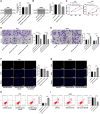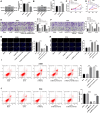Methyltransferase-like 3 facilitates lung cancer progression by accelerating m6A methylation-mediated primary miR-663 processing and impeding SOCS6 expression
- PMID: 35907010
- PMCID: PMC11800879
- DOI: 10.1007/s00432-022-04128-5
Methyltransferase-like 3 facilitates lung cancer progression by accelerating m6A methylation-mediated primary miR-663 processing and impeding SOCS6 expression
Abstract
Objective: Lung cancer (LC) remains a threatening health issue worldwide. Methyltransferase-like protein 3 (METTL3) is imperative in carcinogenesis via m6A modification of microRNAs (miRNAs). This study estimated the effect of METTL3 in LC by regulating m6A methylation-mediated pri-miR-663 processing.
Methods: miR-663 expression in 4 LC cell lines and normal HBE cells was determined using RT-qPCR. A549 and PC9 LC cells selected for in vitro studies were transfected with miR-663 mimics or inhibitor. Cell viability, migration, invasion, proliferation, and apoptosis were detected by CCK-8, Transwell, EdU, and flow cytometry assays. The downstream target genes and binding sites of miR-663 were predicted via Starbase database and validated by dual-luciferase assay. LC cells were delivered with oe-METTL3/sh-METTL3. Crosslinking between METTL3 and DGCR8 was verified by co-immunoprecipitation. Levels of m6A, miR-663, and pri-miR-663 were measured by m6A dot blot assay and RT-qPCR. m6A modification of pri-miR-663 was verified by Me-RIP assay. Finally, the effects of METTL3 in vivo were ascertained by tumor xenograft in nude mice.
Results: miR-663 was upregulated in LC cells, and miR-663 overexpression promoted cell proliferation, migration, invasion, and inhibited apoptosis, but miR-663 knockdown exerted the opposite effects. miR-663 repressed SOCS6 expression. SOCS6 overexpression annulled the promotion of miR-663 on LC cell growth. METTL3 bound to DGCR8, and METTL3 silencing elevated the levels of pri-miR-663 and m6A methylation-modified pri-miR-663, and suppressed miR-663 maturation and miR-663 expression. METTL3 facilitated tumor growth in mice through the miR-663/SOCS6 axis.
Conclusion: METTL3 promotes LC progression by accelerating m6A methylation-mediated pri-miR-663 processing and repressing SOCS6.
Keywords: Lung cancer; Methyltransferase-like 3; Migration and invasion; Primary miR-663; SOCS6; Tumor formation assay; m6A methylation.
© 2022. The Author(s), under exclusive licence to Springer-Verlag GmbH Germany, part of Springer Nature.
Conflict of interest statement
The authors declare that they have no conflict of interest.
Figures







Similar articles
-
MiRNA- 1293 Promotes Hepatocellular Carcinoma Cell Proliferation and Invasion by METTL3-Mediated m6 A Modification of Pri-miRNA- 1293.Appl Biochem Biotechnol. 2025 Jul;197(7):4409-4422. doi: 10.1007/s12010-025-05241-0. Epub 2025 Apr 28. Appl Biochem Biotechnol. 2025. PMID: 40293590
-
Tanshinone IIA Restrains Hepatocellular Carcinoma Progression by Regulating METTL3-Mediated m6A Modification of TRIB3 mRNA.Turk J Gastroenterol. 2025 Feb 4;36(7):431-441. doi: 10.5152/tjg.2025.24304. Turk J Gastroenterol. 2025. PMID: 39910904 Free PMC article.
-
METTL3-mediated circ_0003998 serves as oncogene in non-small cell lung cancer through regulating miR-330-5p/CXCL3 axis.Cell Cycle. 2025 Aug 8:1-15. doi: 10.1080/15384101.2025.2540139. Online ahead of print. Cell Cycle. 2025. PMID: 40776628
-
Exploring m6A methylation in skin Cancer: Insights into molecular mechanisms and treatment.Cell Signal. 2024 Dec;124:111420. doi: 10.1016/j.cellsig.2024.111420. Epub 2024 Sep 19. Cell Signal. 2024. PMID: 39304098 Review.
-
Unraveling the dual role of METTL3-mediated m6A RNA modification in bladder cancer: mechanisms, therapeutic vulnerabilities, and clinical implications.Cancer Biol Ther. 2025 Dec;26(1):2545057. doi: 10.1080/15384047.2025.2545057. Epub 2025 Aug 8. Cancer Biol Ther. 2025. PMID: 40778544 Review.
Cited by
-
Small RNA modifications: regulatory molecules and potential applications.J Hematol Oncol. 2023 Jun 22;16(1):64. doi: 10.1186/s13045-023-01466-w. J Hematol Oncol. 2023. PMID: 37349851 Free PMC article. Review.
-
Novel DNA methylation-based epigenetic signatures in colorectal cancer from peripheral blood leukocytes.Am J Cancer Res. 2024 May 15;14(5):2253-2271. doi: 10.62347/MXWJ1398. eCollection 2024. Am J Cancer Res. 2024. PMID: 38859857 Free PMC article.
-
The critical roles of m6A RNA methylation in lung cancer: from mechanism to prognosis and therapy.Br J Cancer. 2023 Jul;129(1):8-23. doi: 10.1038/s41416-023-02246-6. Epub 2023 Mar 30. Br J Cancer. 2023. PMID: 36997662 Free PMC article. Review.
-
The METTL3/miR-196a Axis Predicts Poor Prognosis in Non-small Cell Lung Cancer.J Cancer. 2024 Jan 21;15(6):1603-1612. doi: 10.7150/jca.92968. eCollection 2024. J Cancer. 2024. PMID: 38370374 Free PMC article.
-
Emerging Mutual Regulatory Roles between m6A Modification and microRNAs.Int J Mol Sci. 2023 Jan 1;24(1):773. doi: 10.3390/ijms24010773. Int J Mol Sci. 2023. PMID: 36614216 Free PMC article. Review.
References
-
- Bi X, Lv X, Liu D et al (2021) METTL3-mediated maturation of miR-126-5p promotes ovarian cancer progression via PTEN-mediated PI3K/Akt/mTOR pathway. Cancer Gene Ther 28:335–349 - PubMed
-
- Chen M, Wei L, Law CT et al (2018) RNA N6-methyladenosine methyltransferase-like 3 promotes liver cancer progression through YTHDF2-dependent posttranscriptional silencing of SOCS2. Hepatology 67:2254–2270 - PubMed
MeSH terms
Substances
LinkOut - more resources
Full Text Sources
Medical
Molecular Biology Databases
Miscellaneous

